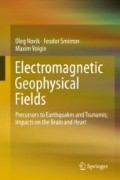Abstract
In this chapter, on the basis of the three-dimensional (3D) dynamic theory of magneto-thermo-elasticity and geological and geophysical input data, the theory of magnetic location of a possible earthquake epicenter area (MLPEEA) has been formulated for the first time and compared (satisfactorily) with the results of electromagnetic (EM) measurements in seismically active regions, published by other authors.
MLPEEA is understood here as an area with measurable repeated emissions of a hertz-range EM field caused by relatively weak (maybe regarded as precursory) seismic excitations.
Because of the different (mechanical and EM) natures of the physical fields involved, the mathematical types of the differential operators included in the seismo-EM interaction model are different as well (hyperbolic and parabolic), and the resulting model is not of a well-investigated type. In our previous works, we mathematically investigated the correctness of the model for the continuous and discretized variables, and we have applied these results here for construction of the model of the magnetic location mentioned.
Practical recommendations for earthquake monitoring are given with application of the developed theory. To demonstrate the stability of the effect of the location in regard to the inevitable uncertainty of the geological input data, we carried out simulations of the magnetic location with different reasonable (from the point of view of geophysics and petrophysics) values of the input parameters. In the course of these computations we observed imprinting of the seismic wave on the EM wave, and we describe this phenomenon in the last part of the chapter.
Access this chapter
Tax calculation will be finalised at checkout
Purchases are for personal use only
References
Arora, B. R., & Mahashabde, M. V. (1987). A transvers conductive structure in the northwest Himalaya. Physics of the Earth Planetary Interior, 45, 119–127.
Hayakawa, M. (2015). Earthquake prediction with radio techniques. Hoboken: Wiley.
Ismaguilov, V. S., Kopytenko, Y. A., Hattori, K., Voronov, P. M., Molchanov, O. A., & Hayakawa, M. (2001). ULF magnetic emissions connected with under sea bottom earthquakes. Natural Hazards and Earth System Sciences, 1, 23–31.
Ismaguilov, V. S., Kopytenko, Y. A., Hattori, K., & Hayakawa, M. (2003). Variation of phase velocities and gradient values of ULF geomagnetic disturbances connected with the Izu strong earthquakes. Natural Hazards and Earth System Sciences, 3, 211–215.
Kopytenko, Yu. A., Ismaguilov, V. S., Voronov, P. M., Kopytenko, E. A., Molchanov, O. A., Hayakawa, M., et al. (1999). Magnetic disturbances in ULF range connected with seismic sources. In Proceedings of the 2nd International Conference on Marine Electromagnetics—Marelec. 99, France (pp. 435–445).
Kopytenko, Y. A., Ismaguilov, V. S., Kopytenko, E. A., Voronov, P. M., & Zaitsev, D. B. (2000). Magnetic location of geomagnetic disturbance sources. Geophysics, 371(5), 685–687.
Maugin, G. A. (1988). Continuum mechanics of electromagnetic solids. Amsterdam: North-Holland.
Novik, O. B. (1969). The Cauchy problem for a system of PDEs including the hyperbolic and parabolic operators. Journal of Computational Mathematics and Mathematical Physics, 1, 122–136. (In Russian. Задача Коши для системы УРЧП, содержащей гиперболический и параболический операторы. ЖВМиМФ, 1969, No 1, с. 122–136).
Novik, O. B. (1994). Seismogenic magnetothermoelastic effect. In Doklady (Trans) Russian Academy of Sciences, 338(2), 238–241 (In Russian).
Novik, O. B. (1995). The Galerkin method for a three-dimensional nonlinear system of magnetothermoelasticity equations. In Doklady (Trans) Russian Academy of Sciences, 335A, 15–21 (Translated from Russian: Doklady Rossiyskoy Akademii Nauk, 1994, 334, No 2, pp. 100–102).
Novik, O. B., & Ershov, S. V. (2001). Electromagnetic and temperature signals from the Earth’s depth (255 p.). Moscow: Scientific Monographs of Federal Program of Integration of High Education and Fundamental Science (In Russian).
Robb, L. (2005). Introduction to ore-forming processes (368 p). Hoboken: Blackwell.
Schön, J. (2011). Physical properties of rocks: A workbook. In Handbook of petroleum exploration and production (Vol. 8, 481 p.). Amsterdam: Elsevier.
Author information
Authors and Affiliations
Rights and permissions
Copyright information
© 2019 Springer Nature Switzerland AG
About this chapter
Cite this chapter
Novik, O., Smirnov, F., Volgin, M. (2019). Theory of Magnetic Location of a Possible Earthquake Epicenter Area. In: Electromagnetic Geophysical Fields. Springer, Cham. https://doi.org/10.1007/978-3-319-98461-2_2
Download citation
DOI: https://doi.org/10.1007/978-3-319-98461-2_2
Published:
Publisher Name: Springer, Cham
Print ISBN: 978-3-319-98460-5
Online ISBN: 978-3-319-98461-2
eBook Packages: Earth and Environmental ScienceEarth and Environmental Science (R0)

